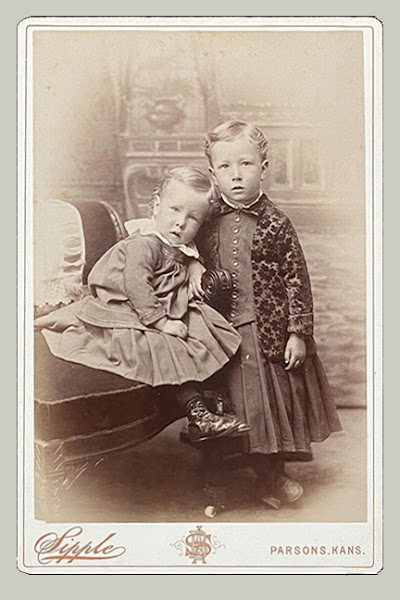Included on this special set of pages are Cabinet Card examples from just one state, Kansas. A sort of index. They are presented here in alphabetical order according to location.
Why Kansas?
In 1865, when the Cabinet Card size for photo mounts began its popularity, Kansas had only been a state for 4 years. Even today there are more than 400 towns with a population less than 400. Back then, even more. Where a Cabinet Card carries the name of the photographer and the town where he was working, the dates of city incorporation will be one clue to the date of the cabinet card.
Cabinet Cards were so popular and well known that in some photographer’s newspaper ads of the era, they were referred to merely as “Cabs”.
Cabinet Cards were so popular and well known that in some photographer’s newspaper ads of the era, they were referred to merely as “Cabs”.
Most say they eventually surpassed the popularity of the Carte de Viste format. See a brief history of the Carte de Viste.
Photographers often lived and based in a larger town and “worked” the neighboring smaller towns monthly or weekly. The passenger trains were very handy back then.
Where further information on a photographer is known, a link will be provided.
The central purpose in these pages is to help place a date on cabinet cards done by various photographers in various places. Here’s hoping you spot a card design or imprint that will help you date and identify that card in your collection.
These pages are for educational and informational purposes only. Any helpful suggestions are welcomed.
Kansas Cities, Towns, Burgs and Whistlestops in the late 19th century.
Promoting the care, understanding and collection of this unique format of 19th century photography. They are more than 100 years old. Handle with care.
Some examples on this page have been enhanced or restored for clarity
and presentation here.
This page is free for educational and research purposes only but, as
always, if the original owner of any of these examples objects to the
use on this page, just let me know and they will be immediately
removed.
See also:
Owlcation is an excellent site which examines the Kansas photographers of the 19th century. Follow the link
According to newspaper ads, J W Oberholtzer and Carter worked together in Paola, KS, from November of 1892 to February of 1894.
Oberholtzer continued in Paola until at least late 1897 before moving on.
Ernest Frank Carter was his step-son.
More about Joshua Oberholtzer.
service area includes Vinita, Muskogee,
Eufalla and Mcalester in Indian Territory
See the rich history of Peabody, KS, on Wikipedia.
Cora Willett (at age 21) and her father, George Willett, purchase a gallery in Peabody, KS, in September of 1892. They apparently operate there until May of 1895 when Cora marries H P Crego and moves away from Kansas. George Willett then operates out of a railroad car for several years.
Phillipsburg, KS
(George A Locke, 1860-1925?) (C Stephen Cobb, 1829-1904)
As partners, they had studios in Phillipsburg, Kerwin and Kensington.
In later years, Locke also had a photo-car.
The partnership lasted from 1894 to 1904
example from auction site
The card at the left is NOT a cabinet card but an example of post 1900 mounting. See Ferguson cabinet card work examples in Deighton and Holton Kansas.
Note that the same chair is used in the next two cards by Hinman.
Pittsburg, KS
(Also of Baxter Springs, KS)
example from mj aux on Flickr
Pittsburg, KS
(Also of Baxter Springs, KS)
example from auction site
Pleasanton had its start in the year 1869 by the building of the Kansas City, Fort Scott & Memphis Railroad through that territory. It was named in honor of General Alfred Pleasonton, though the city name is spelled differently. The first post office in Pleasanton was established in August 1869.
Pleasanton, KS
example from the Flickr collection of mj aux (W F Shults bought the Hughs gallery in Pleasanton, KS, from A D Hughs in Jun 1889 and then sells it to the Bissel sisters in Jun 1889.)
Pratt was founded in 1884 and named after Caleb S. Pratt, a young Civil War officer from the Kansas Infantry, who was killed in the Battle of Wilson's Creek near Springfield, Missouri.
The first post office in Pratt was established in June 1884.
Pratt, KS
example from auction site
L J Studebaker and Will Farmer were partners working in Pratt, Kansas in most of 1894. They continued through early 1895 working in area towns.
Randall was originally called Vicksburg, and laid out in 1870. It was renamed Randall in 1882.
Riley was originally called Union, and under that name was founded in 1871. It was renamed Riley Center in the late 1870s. Riley was the name of a railroad employee.
Russell was incorporated and named the provisional county seat in 1872, and, after a two-year dispute with neighboring Bunker Hill, it became the permanent county seat in 1874.
Not the one you were looking for? Here's the photographer's
INDEX by name.
All the Cabinet Card photographers of the 19th
century found in LOST GALLERY are listed there.
This is a work always in progress.
Additional information and New examples are always welcome. Any
additional information will help narrow the time that these precious
antiques were made.
All submissions should be free of glare and
shadows.
Do not crop.
Leave a border around each card. The edges are
sometimes an important clue to the age of the card.
Email to the address found in the profile at the bottom of this page.
Some examples on this page have been enhanced or restored for clarity
and presentation here.
This page is free for educational and research purposes only but, as
always, if the original owner of any of these examples objects to the
use on this page, just let me know and they will be immediately
removed.









































































No comments:
Post a Comment